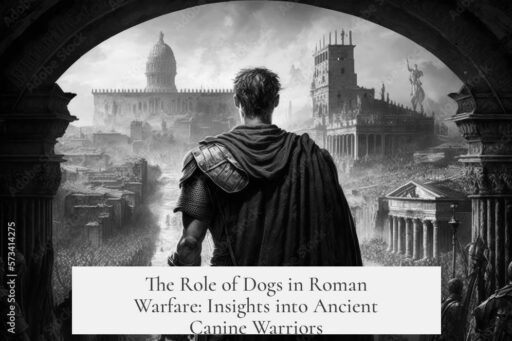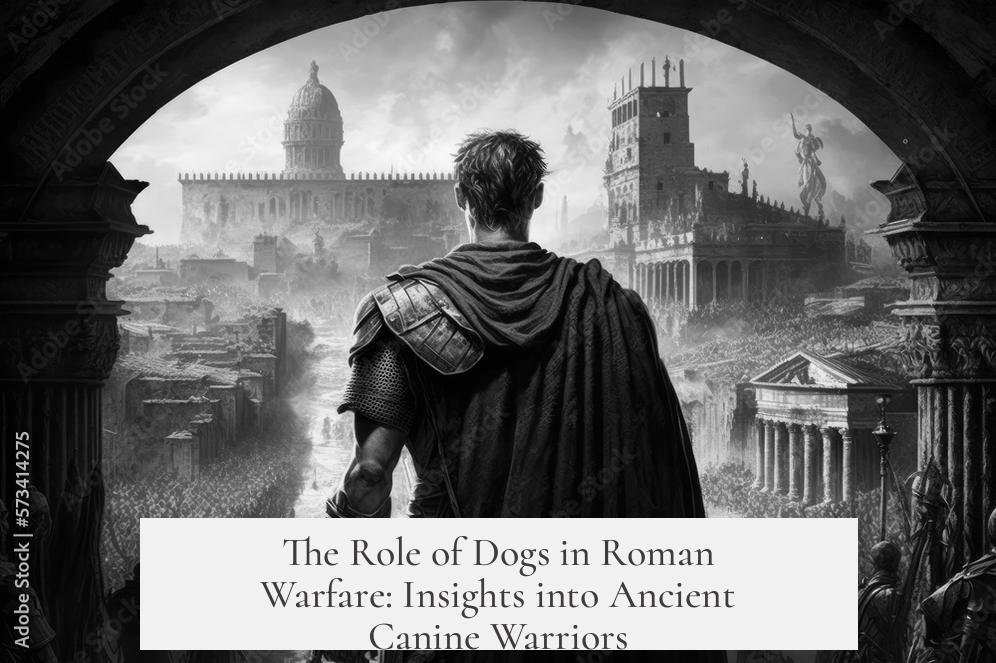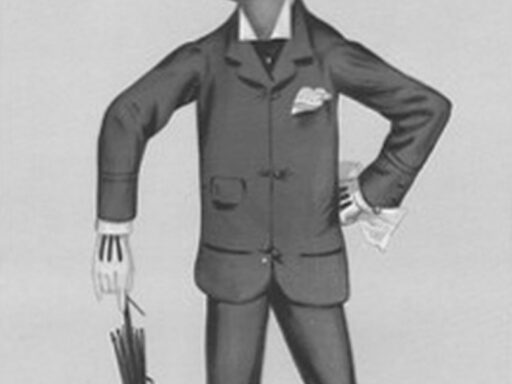The Romans did use dogs during wartime, but primarily for sensory and auxiliary roles rather than as direct frontline combatants. Evidence shows dogs served mainly as sentinels, scouts, and guardians. The concept of Roman war dogs used aggressively in battle formations lacks strong historical support and appears exaggerated in popular media.

Roman troops valued dogs for their acute senses. Livy (5.47) records dogs accompanying sentinels on the Capitoline Hill during the Gallic sack of Rome. Although these dogs failed to detect the surprise attack, their use to bolster night watch suggests a sensory role. Additionally, dogs likely assisted in tracking or uncovering enemies, as implied by references to locating hidden foes in Sardinian caves.
Regarding frontline combat roles, documented examples are scarce. Roman military manuals and historical texts lack clear descriptions of dogs attacking enemies or serving as battle units. Much of the imagery of “war dogs” in Roman battle scenes likely derives from artistic interpretation or later reconstructions rather than solid facts.

However, there is some indirect evidence about Roman war dogs:
- In 391 AD, Consul Quintus Aurelius Symmachus mentioned receiving seven “canes Scotici,” regarded as war dogs capable of fighting large animals and possibly used in warfare.
- Pliny the Elder’s *Naturalis Historia* discusses war mastiffs, though the reliability of some claims in this source is questionable.
- Battle depictions occasionally feature dogs alongside soldiers, but these are not definitive proof of systematic military use.
In contrast, other ancient cultures like the Celts used large dogs for war roles. Julius Caesar noted Irish Wolfhounds as formidable war dogs in *The Gallic Wars*, revealing a tradition of canine combat in various peoples neighboring Rome.

| Aspect | Roman Practice |
|---|---|
| Sentinel/Guard Dogs | Yes, used for alert and scouting. Example: Capitoline Hill guards with dogs. |
| Frontline Attack Dogs | No strong evidence; likely exaggeration or later myth. |
| War Dogs in Literature | Some mentions (Pliny, Symmachus) but inconsistent reliability. |
| Other Cultures | Celtic use of Irish Wolfhounds for war; Julius Caesar’s account. |
The image of Roman war dogs as aggressive battlefield troops mostly comes from modern interpretations or entertainment media, rather than ancient records. They were more commonly part of surveillance and protection strategies, enhancing the army’s sensory capabilities.
- Romans used dogs mainly for sensing and guarding, not as frontline fighters.
- Recorded evidence for combat use of war dogs in Rome is minimal and uncertain.
- Other ancient cultures integrated dogs into combat roles more actively.
- Roman war dogs appear in literature but with limited reliability.
Did the Romans Use Dogs in War? Unleashing the Truth About Rome’s Canine Warriors

If you’ve ever wondered, “Did the Romans use dogs in war?” the answer is nuanced but clear: Romans did use dogs during wartime, but not quite in the dramatic frontline charge way some might imagine.
Roman history, as detailed in ancient texts and archaeological clues, shows dogs mostly served specific support roles—less as sword-wielding companions and more as sensory reinforcements and symbols of power. Let’s walk through the evidence.

First, the Romans certainly recognized the superior senses of dogs, especially for _security purposes_. Livy’s account (5.47) during the sack of Rome by the Gauls narrates Roman sentinels on the Capitoline Hill were accompanied by dogs tasked to alert the defenders of intruders. Unfortunately, those canine sentries missed a surprise night attack. Although the dogs failed, it’s intriguing that geese, of all creatures, noticed the threat instead, foiling the assault. So, yes, dogs were on patrol, but not infallible.
Moreover, there are references—admittedly more fragmentary—about dogs being used to sniff out enemies hiding in caves, particularly on the island of Sardinia. It makes sense: dogs’ acute noses have always been a valuable asset in reconnaissance missions. Can you imagine enemy soldiers trying to hide from snuffling war dogs? Not very effective.

Turning now to direct combat, the picture gets hazier. Unlike the dramatized portrayals in video games or movies where war dogs charge into battle biting and tearing through foes, there’s very little solid historical evidence that Roman armies deployed dogs as frontline fighters. This absence isn’t due to lack of interest but rather to the scarcity of records validating such use. The famous “flaming pigs” launched at war elephants have some historical basis, but no similar widespread dog-charge tactic has found solid roots in Roman military chronicles.
We have a colorfully documented exception from the late Roman period: Consul Quintus Aurelius Symmachus, writing in 391 AD, mentions receiving seven “canes Scotici”—literally “Scottish dogs” or large mastiff-type dogs—intended for use in war, as well as for fighting wild beasts like lions and bears. According to him, these dogs were a sight that “all Rome viewed with wonder.” This suggests that these dogs were at least recognized for their prowess in combat or defense, although how exactly Symmachus intended to deploy them militarily remains vague.
Even the famously detailed Naturalis Historia by Pliny the Elder (about 80 AD) describes mastiff-like dogs used for fighting. But historians approach Pliny’s work with caution, given that he sometimes blends fact with hearsay and myth. Still, his mention supports the idea that robust, aggressive dogs were valued in some martial or protective capacity.
Visual evidence, like battle depictions, occasionally shows dogs among soldiers, but these images don’t clarify whether the dogs were for combat or companionship. One can easily connect this with ancient special forces units experimenting with animals in auxiliary roles, as some modern documentaries and YouTube clips have explored.
For context, it helps to look beyond Rome. The Celts, Roman enemies and neighbors, famously bred Irish Wolfhounds—giant war dogs noted by Julius Caesar in Commentarii de Bello Gallico. These dogs were bred for battle, capable of intimidating and overpowering enemies. The Romans might have admired or even borrowed this practice, but their own military records shy away from mentioning similar canine shock troops.
Why would that be? Roman warfare was highly organized. They used formations, discipline, technology, and psychology more than brute force from animals in frontline combat. Dogs filled specific roles—guards, trackers, perhaps morale boosters—but weren’t the cavalry replacements some have imagined.
What Can We Learn From This?
Dogs have always been humanity’s sidekicks—from herding sheep to sniffing out dangers. The Romans were no exception. They leveraged dogs mostly for their senses—especially hearing and smell—to protect camps and detect threats lurking in the shadows. These dogs enhanced human capabilities without charging headlong into enemy phalanxes.
But they weren’t just passive tools. A gift of war dogs like Symmachus’s seven “canes Scotici” hints at a symbolic prestige surrounding powerful dogs in Roman society. Imagine the reactions at that time: warriors and nobles alike marveling at these fierce beasts—partly practical, partly status symbols.
Imagine Roman generals consulting with their canine cohorts before a mountain raid or a night guard duty. The dogs wouldn’t wear helmets or carry swords. They likely earned their place with sharp senses and imposing presence.
In Closing: Was Rome Puppy-Ready for War?
Did Romans use dogs in war? Absolutely, but mostly as security guardians and scouts armed with noses and teeth, rather than “dog soldiers” as action games like to portray. Though framed occasionally as warriors themselves—especially in later periods or in imperial gifting—the core Roman approach favored training dogs for sensory and defensive roles.
So next time you see an Ancient Rome game with charging war dogs, give a chuckle. The reality credits dogs with loyalty and usefulness, just not quite the gladiatorial bite they imagine.
Got a favorite historical tidbit about ancient war animals? Share it! Because dogs might have been Rome’s silent partners on the battlefield, but their legacy deserves a louder bark.




